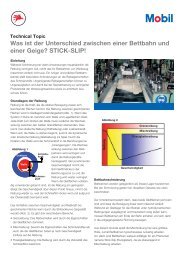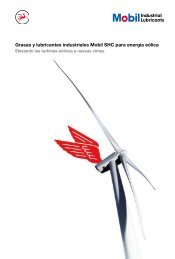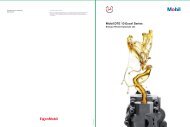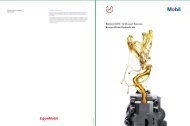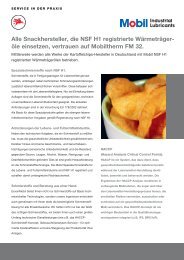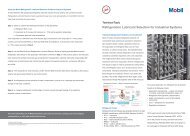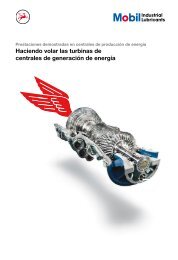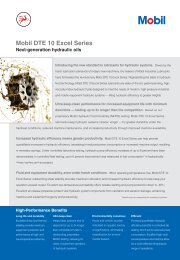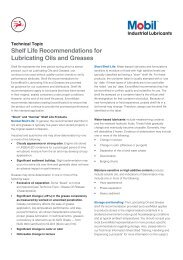Hydraulic Fluid Shear Stability - Mobil™ Industrial Lubricants
Hydraulic Fluid Shear Stability - Mobil™ Industrial Lubricants
Hydraulic Fluid Shear Stability - Mobil™ Industrial Lubricants
Create successful ePaper yourself
Turn your PDF publications into a flip-book with our unique Google optimized e-Paper software.
Technical Topic<strong>Hydraulic</strong> <strong>Fluid</strong> <strong>Shear</strong> <strong>Stability</strong>Machinery and the lubricants that protect them are often exposedto a wide variety of ambient and operating temperatures. As aresult, lubricants are often required to maintain good pumpabilityat low temperatures and sufficient film strength at high temperatures.Prime examples are hydraulic fluids used in industrial and mobileequipment applications that operate in a wide range of environmentsand temperatures. It is not difficult to find a lubricant to meetthese requirements, but there can be performance concerns ifthe fluid is not properly formulated. <strong>Fluid</strong>s with a wide operatingtemperature range are often formulated with special viscosityimprover additives to improve both high and low temperatureviscometrics; and these additives are subject to shearing forcesthat can reduce their effectiveness in service.Viscosity Index ImproversThe VI of a fluid can be enhanced through the use of specializedadditives called Viscosity Index Improvers. These additives aretypically high molecular weight polymers designed to minimizetemperature’s impact on viscosity. VI improvers swell with increasingtemperature which counteracts the decreasing viscosity of thebase fluid. This results in a fluid that maintains sufficient oil filmthickness at high temperatures. At lower temperatures, VIimprovers shrink and the properties of the base oil dominate theviscosity of the fluid.The viscosity temperature relationshipThe viscosity of lubricants changes with temperature. As temperaturerises, viscosity decreases, and as temperature decreases, viscosityincreases. A measure of the relative rate of change of viscositywith temperature is referred to as the fluid's Viscosity Index, or VI.Viscosity Index is an empirical, unit-less number used to quantifythe change of viscosity with respect to temperature. The viscosityof a fluid with high VI does not change as rapidly with temperaturewhen compared with a lower VI fluid. For mineral hydraulic fluids,typical VI is between 90 and 110.Low Temperature: VI ImproverMolecules ContractHigh Temperature: VI ImproverMolecules Expand<strong>Shear</strong> <strong>Stability</strong> MeasurementsThere are three commonly used methods for determining theshear stability of a high VI fluid.THICKViscosityTHINIncreased PumpabilityIncreased Wear ProtectionVI ImprovedNon VI ImprovedCOLD Temperature HOTWhat is VI? (Viscosity Index)DIN 51382 – The Bosch Injector Test is considered to be the leastsevere of these methods. The test oil is run through 250 cycles at2550 psi and the change in viscosity is measured.ASTM D5621 – The Sonic <strong>Shear</strong> method functions by shearingthe sample hydraulic fluid in a sonic oscillator for 40 minutes andthe change in viscosity is measured. This test is favored by someUSA OEMs, but is increasingly being replaced by the CEC L45-A-99 KRL Tapered Roller Bearing Test.CEC L45-A-99 - The KRL Tapered Roller Bearing test is becomingthe test of choice of many OEM’s around the world, as it isconsidered the most severe and offers the best correlation to actualfield performance. Test oil is run in a fitted tapered roller bearingfor 20 hours under design load. Before and after viscosities arecompared for percent viscosity loss.
The graph below shows a 12.6% reduction in viscosity shear lossfrom a shear unstable oil to a shear stable oil as tested in the KRLTapered Roller Bearing test.% Viscosity loss<strong>Shear</strong> <strong>Stability</strong> Application Testing: <strong>Hydraulic</strong> PumpsWhile laboratory tests provide useful data on shear stability ofhydraulic fluids, another method is to measure shear stabilityin an operating hydraulic pump. Testing in a hydraulic pumpreplicates the forces and conditions encountered in everyday use.In the example below, data was collected from two fluids in aVickers 25 VQ Vane Pump test rig run at 138 bar (2000 psi)and 52°C (125°F) for 168 hours.% of Initial Viscosity20181614121086420110%100%90%80%70%5.8<strong>Shear</strong> Stable18.4<strong>Shear</strong> Unstable20 Hour KRL Test (CEC L-45-A-99)VG 46VG 32VG 2260%0 1 2 3 4 5 6 7Time (Days)<strong>Shear</strong> Stable<strong>Shear</strong> UnstableInitial ViscosityIn this example, the shear unstable high VI hydraulic fluid suffered anearly 30 percent viscosity loss in just two days and falls out of theISO viscosity grade in less than one day of pump operation. Onthe other hand, a more shear stable formulation retains consistentviscosity for the duration of the test. The differentiation has asignificant implication in the lubrication and operation of ahydraulics system.Impact of <strong>Shear</strong> <strong>Stability</strong>: Temperature OperatingWindow (TOW) and “Afternoon Fade”Excessive permanent shear, as shown in the previous example,has serious implications for a hydraulic system. As shear increases,the fluid's Temperature Operating Window (TOW) decreases. TheTOW of a hydraulic fluid is a measure of the minimum and maximumtemperature operating range. A hydraulic fluids’ TOW is dependenton initial viscosity, VI. The effective TOW seen in the field is alsoimpacted by shear stability as illustrated below, where a shear stablefluid has a broader TOW than a less shear stable fluid of higher VI.Temperature109.4-C78-C-31.4-C<strong>Shear</strong> StablePre shear viscosityMin Visc 13cSt – aftershearMax Visc9.300 cSt –No Load<strong>Shear</strong> UnstableEffective Temperature Operating WindowIncreasing shear reduces the high temperature properties of thefluid by lowering the viscosity. As an example, consider the twofluids used in the pump test. The equipment OEM recommendsan ISO VG 46 hydraulic fluid for the expected operating temperatures.Based on the vane pump rig testing, within one day's time, theshear unstable ISO VG 46 fluid has dropped to an ISO VG 32; inless than two days, the oil has even dropped out of ISO VG 32grade. This loss in viscosity would likely increase wear during elevatedtemperature operation, which could lead to equipment failure.Additionally, the lower viscosity could result in what many operatorsrefer to as “afternoon fade.” Increasing system and ambienttemperatures commonly occur as a machine works late into theday. When temperatures rise, viscosity decreases and the volumetricefficiency of the system pumps diminishes. The result is a reductionof volume output from the pumps, slowing the response speed ofthe actuators in the system. <strong>Fluid</strong>s with a high amount of shear lossmay experience proportionately more “afternoon fade” comparedto fluids that have higher shear stabilities, ultimately reducing theproductivity of the machine.ConclusionThe ability of a hydraulic oil to maintain optimum viscosity under awide temperature operating window can be achieved with a shearstable, high VI, hydraulic fluid. Well formulated, shear stable, high VIhydraulic fluids have been tested to maintain optimum lubricantviscosity maintaining a wide temperature operating window andpreventing a decrease in volumetric efficiency.65-C-37.9-C102.5-CTemperature Operating Window (TOW)www.mobilindustrial.com© 2009 Exxon Mobil CorporationMobil and the Pegasus design are registered trademarks of Exxon Mobil Corporation or one ofits subsidiaries.HY8011SH



